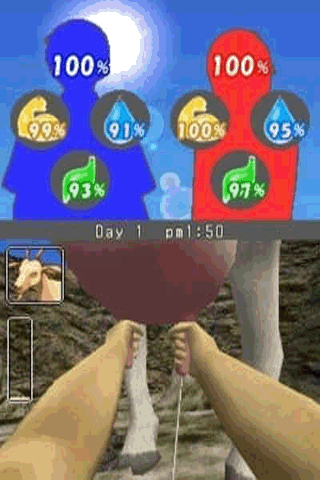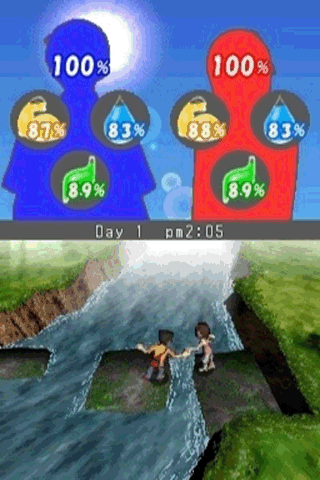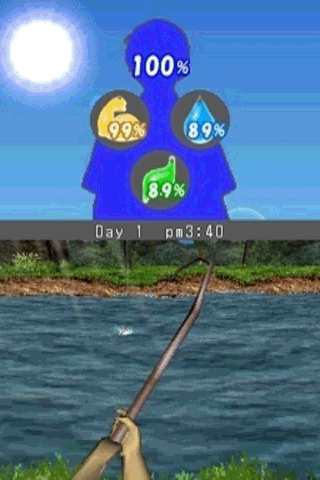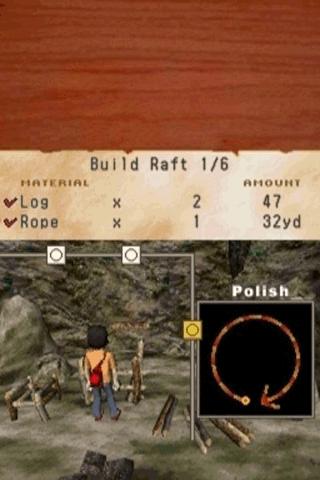![]() What it would be like to be stranded on an island, forced to work for your own survival, with no one to keep you company other than a member of the opposite sex? For anyone who’s ever pondered such questions, and even for those who haven’t, Lost in Blue is the answer.
What it would be like to be stranded on an island, forced to work for your own survival, with no one to keep you company other than a member of the opposite sex? For anyone who’s ever pondered such questions, and even for those who haven’t, Lost in Blue is the answer.
A new and innovative game for the Nintendo DS, Lost in Blue is the story of a boy and a girl stranded alone on an island. While the premise may sound simplistic at first, the gameplay is far from easy, involving a combination of hunting and gathering, exploration, puzzles, an interactive storyline, and of course, not dying from starvation and exhaustion.
You begin the game as Keith, a teenage boy washed ashore on a strange land and without a single possession to his name. Before the end of the first day, you’re required to forage for food on the beach, find the means to make a fire and find a cave for shelter in order to survive. After a little bit of exploration, you find the girl, Skye, also washed up on the beach, and bring her back to your cave to cook for you, which is pretty much all she does.
Once you have the basics down, the game settles into a rather nice rhythm—which is not to say that it ever gets boring. There are many different aspects of the game to balance at all times, and just when it starts to feel too repetitive, there always seem to be new places to explore and new goals to focus on.
For example, keeping both you and the girl fed is vital, of course, but the manner in which you do so is widely varied. It’s easy to simply wander around and gather coconuts and seaweed on the beach, or dig up clams and root vegetables; but as you find more materials and learn how to make tools, it’s also fun to go fishing or hunting, or to set traps for the animals that you can’t catch any other way.
When you’re not making sure you have enough food in your stomach to get through another day, you can build furniture and tools—the tools are definitely useful and even necessary for other parts of the game, while the furniture appears more often as a sort of minigame utilizing the touch screen and stylus (more on that later).
The relationship aspect between the two characters is dynamic and depends entirely on how you treat the girl, how you respond to her questions, etc. There are also quite a few cutscenes throughout the story that give the characters more depth and history, giving you a chance to influence their current connection to each other as well. Romance is definitely possible, but optional.
And just so you don’t get too distracted with the various side parts of the game, there is, in fact, an overall objective—to escape from the island. This mostly hinges on exploring the island, which is a lot bigger than you might expect, but there are also many, many puzzles. These include your typical “bring the other character with you to a place so you can both hit switches at the same time” puzzles, which at least serve to make you get the girl out of the cave every once in a while, and aren’t all that annoying, really.
There is also a surprisingly long series of crate-pushing puzzles to get through, which range from really, really easy to making me try a gazillion times before growling in frustration and then actually stopping playing. I should probably mention that I’ve been playing this game a lot recently. I actually like crate-pushing puzzles, so this wouldn’t be a bad thing at all if it weren’t for the fact that pushing crates around makes your character tired, gosh darnit, so you have to leave the puzzles and go all the way back to your cave to rest after only a little while.
I guess at this point I should actually start talking about what I think about this game.
In short: I love it. This is, more or less, the quintessential Lizo game. Now, I know this doesn’t necessarily mean that you’ll love it, but I’ll try to at least give it a fair representation, and then you can decide from there.
I found this game to be a lot of fun, once I got past the first few days of gameplay and got used to the way the system works. I’m a big fan of trying to find every item possible, and there are plenty of things to collect, all recorded for you in your handy-dandy scrapbook: vegetables, animals, seafood, tools, tooons of stuff, and I’ve still yet to find it all. Plus, the storyline’s fun and engaging, which is always a plus.
The music isn’t fall-on-the-floor amazing—it’s suitable for what the game is, and is quite pleasant to listen to. The sound effects in the game are nice, and not at all annoying, and the characters even say short phrases/words sometimes, which makes me happy.
The graphics in the game may turn some people off. When you’re moving around on the bottom screen, the 3D characters appear a bit blocky, and this is especially clear in the ending cutscenes; but the anime-esque portraits that appear during conversations and on the top screen occasionally are beautiful and expressive. And besides, even if the characters in their 3D form aren’t perfectly top-of-the-line, they move smoothly, and actions like climbing and jumping are actually a pleasure to watch—especially when you have the girl in tow, which makes bringing her places less of a chore.
The controls are one of the best parts of this game; the developers seem to have taken the DS’s abilities into consideration and came up with something that really shows off the system’s features. The game makes heavy use of the touch screen and stylus, with actions such as digging involving scratching around in the dirt with your stylus, and with the ability to actually “catch” small animals with your hands by touching and dragging on the screen.
Various minigames, including the furniture-building sections of the game, require a sequence of motions of the stylus on the touch screen, as well as puffs of breath into the microphone. Starting a fire involves pressing buttons to simulate spinning a stick between your hands, and then blowing to get the resulting spark to ignite. One of the later minigames even involves flipping the DS shut for a certain number of seconds and then opening it again once the proper time has passed.
The rest of the controls are simple and intuitive: hold one button to run, press another button for the menu, another button to perform whatever action is available at the moment, and so on. You equip tools in the menu and use them when appropriate, and can even hold the girl’s hand with the press of a button.
There are many different endings to this game, depending on which way you choose to escape from the island and what the characters’ relationship is like, so the desire to replay the game to check out different endings is high enough. But then there’s the fact that once you beat the game as Keith you can replay it as Skye, which provides a completely different experience to the story.
The fun part about playing as the girl is that you basically just sit around and cook, trying to discover new recipes (which is hard—I can’t frickin’ figure any out by myself), and telling the boy what to do. He does all the exploring and the hunting and gathering, and you can make time pass more quickly by holding down the Y button. Plus, it’s cool to see his facial expressions during conversations for a change, after seeing Skye’s face for hours and hours of gameplay.
All in all, I love Lost in Blue, and there’s still a ton more interest in it for me, even after playing it for days on end during the post-Christmas era. It’s the only game I’ve really wanted to get for DS (in fact, it’s pretty much the only reason I wanted to get a DS), and it certainly hasn’t disappointed. If you’re at all interested in simulation games, or survival games, or adventure games, or puzzle games, go ahead and give Lost in Blue a shot. It’s lovely. 🙂





